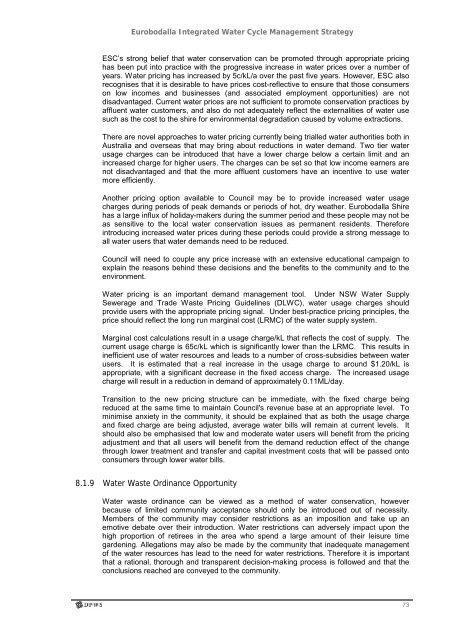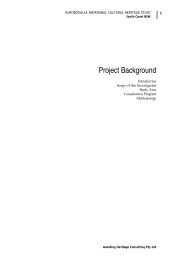Eurobodalla Integrated Water Cycle Management Strategy
Eurobodalla Integrated Water Cycle Management Strategy
Eurobodalla Integrated Water Cycle Management Strategy
Create successful ePaper yourself
Turn your PDF publications into a flip-book with our unique Google optimized e-Paper software.
<strong>Eurobodalla</strong> <strong>Integrated</strong> <strong>Water</strong> <strong>Cycle</strong> <strong>Management</strong> <strong>Strategy</strong><br />
ESC’s strong belief that water conservation can be promoted through appropriate pricing<br />
has been put into practice with the progressive increase in water prices over a number of<br />
years. <strong>Water</strong> pricing has increased by 5c/kL/a over the past five years. However, ESC also<br />
recognises that it is desirable to have prices cost-reflective to ensure that those consumers<br />
on low incomes and businesses (and associated employment opportunities) are not<br />
disadvantaged. Current water prices are not sufficient to promote conservation practices by<br />
affluent water customers, and also do not adequately reflect the externalities of water use<br />
such as the cost to the shire for environmental degradation caused by volume extractions.<br />
There are novel approaches to water pricing currently being trialled water authorities both in<br />
Australia and overseas that may bring about reductions in water demand. Two tier water<br />
usage charges can be introduced that have a lower charge below a certain limit and an<br />
increased charge for higher users. The charges can be set so that low income earners are<br />
not disadvantaged and that the more affluent customers have an incentive to use water<br />
more efficiently.<br />
Another pricing option available to Council may be to provide increased water usage<br />
charges during periods of peak demands or periods of hot, dry weather. <strong>Eurobodalla</strong> Shire<br />
has a large influx of holiday-makers during the summer period and these people may not be<br />
as sensitive to the local water conservation issues as permanent residents. Therefore<br />
introducing increased water prices during these periods could provide a strong message to<br />
all water users that water demands need to be reduced.<br />
Council will need to couple any price increase with an extensive educational campaign to<br />
explain the reasons behind these decisions and the benefits to the community and to the<br />
environment.<br />
<strong>Water</strong> pricing is an important demand management tool. Under NSW <strong>Water</strong> Supply<br />
Sewerage and Trade Waste Pricing Guidelines (DLWC), water usage charges should<br />
provide users with the appropriate pricing signal. Under best-practice pricing principles, the<br />
price should reflect the long run marginal cost (LRMC) of the water supply system.<br />
Marginal cost calculations result in a usage charge/kL that reflects the cost of supply. The<br />
current usage charge is 65c/kL which is significantly lower than the LRMC. This results in<br />
inefficient use of water resources and leads to a number of cross-subsidies between water<br />
users. It is estimated that a real increase in the usage charge to around $1.20/kL is<br />
appropriate, with a significant decrease in the fixed access charge. The increased usage<br />
charge will result in a reduction in demand of approximately 0.11ML/day.<br />
Transition to the new pricing structure can be immediate, with the fixed charge being<br />
reduced at the same time to maintain Council's revenue base at an appropriate level. To<br />
minimise anxiety in the community, it should be explained that as both the usage charge<br />
and fixed charge are being adjusted, average water bills will remain at current levels. It<br />
should also be emphasised that low and moderate water users will benefit from the pricing<br />
adjustment and that all users will benefit from the demand reduction effect of the change<br />
through lower treatment and transfer and capital investment costs that will be passed onto<br />
consumers through lower water bills.<br />
8.1.9 <strong>Water</strong> Waste Ordinance Opportunity<br />
<strong>Water</strong> waste ordinance can be viewed as a method of water conservation, however<br />
because of limited community acceptance should only be introduced out of necessity.<br />
Members of the community may consider restrictions as an imposition and take up an<br />
emotive debate over their introduction. <strong>Water</strong> restrictions can adversely impact upon the<br />
high proportion of retirees in the area who spend a large amount of their leisure time<br />
gardening. Allegations may also be made by the community that inadequate management<br />
of the water resources has lead to the need for water restrictions. Therefore it is important<br />
that a rational, thorough and transparent decision-making process is followed and that the<br />
conclusions reached are conveyed to the community.<br />
73

















